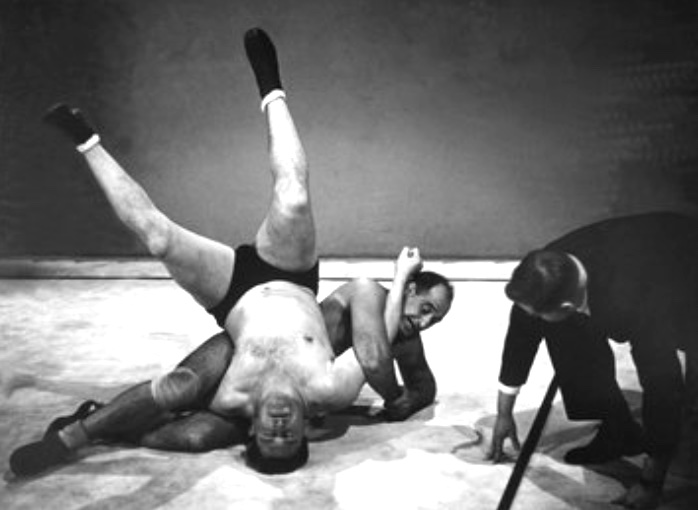OTD in early British television: 12 March 1938

The 100th original post in this series.
John Wyver writes: Closing out transmissions on Saturday 12 March 1938 was An Exhibition of Catch-as-Catch-Can Wrestling, featuring a bout in the studio between Earl McCready, heavyweight champion of the British Empire who hailed from Canada, and the South African grappler Percy Foster. Remarkably, a photograph exists of this contest, which is reproduced above, and for more about wrestling in 1938, go here.
Catch-as-Catch-Can Wrestling, or Catch Wrestling, is apparently (thanks Wikipedia) ‘an English wrestling style where wrestlers aim to win by pinning or submitting their opponent using any legal holds or techniques. It emphasizes adaptability and seizing opportunities during the match, with fewer restrictions than other wrestling styles.’ Following this March debut on screen, the sport was a popular attraction for pre-war television, and was one strand in the new medium’s apparent fixation with looking at bodies in motion.
Looking across the pre-war schedules, television seems to have been fascinated by moving bodies, and especially those engaged in forms of movement that are somehow excessive, whether dancing, giving gymnastic displays, acting as mannequins in fashion parades, demonstrating various sports including ski-ing, fencing and Ju-Jitsu, or performing variety acts on roller skates.
Displays of these kinds were given both in the AP studios, as in the autumn 1937 series Body-line, which ran through a host of keep-fit exercises, and also, as with several demonstrations by The Women’s League of Health and Beauty, in the grounds around the palace.
The visual presentation of movement was, of course, a usp for television, and it was great novelty to see this in the home. The screen size and relatively poor image definition, at least by later standards, meant that full-length shots of one or a small number of bodies, were well-suited as complements to the close-ups of faces that otherwise dominated television’s visual language.
One or just a few bodies could also be easily accommodated in the constricted spaces of the two AP studios, where shots of crowds were impossible to achieve. But there are perhaps other aspects to early television’s fascination with bodies in movement.
One element, given the near-nakedness of our wrestlers, along with boxers, gymnasts and keep-fit demonstrators, was the sense of permitted – and entirely unacknowledged – eroticism, which also enhanced the shots of synchronised dancing bodies in skimpy costumes, whether in ballets or revues.
Another, equally unrecognised, was almost certainly the reassurance and comfort that images of sound and healthy living bodies brought into the homes of families that for the past two decades had lived with lost, destroyed and deeply damaged bodies from the Great War.
In a display of attractive women’s physiques, disciplined and co-ordinated, just as in a tussle between the muscled and oiled figures in a wrestling contest, the world that had been ripped apart after 1914 was somehow, in the smallest of ways, restored and made whole once again.
Leave a Reply